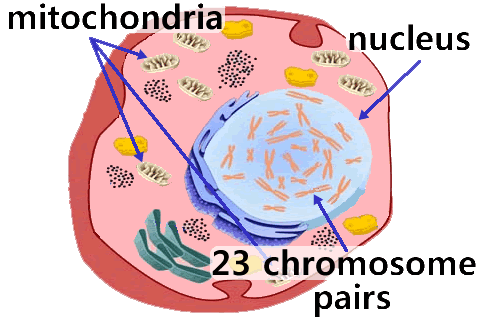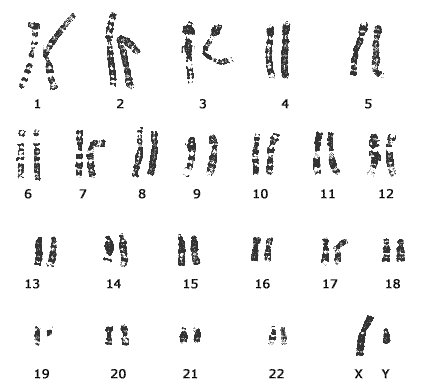Introduction to Genetic Genealogy
Genetic Genealogy is the use of DNA to provide information about recent and ancestral relationships and this is a very basic introduction to that scientific discipline. * It is important to understand that DNA is a powerful tool to assist with traditional genealogy methods but DNA alone cannot provide names, dates or places and must be used in conjunction with traditional genealogy research.
Genealogy
Genealogy is the study of family relationships – both ancestors and descendants. It traditionally involves researching legal documents, e.g. birth and death certificates, census records, family records and letters, publications and interviewing people to learn of family oral histories. But all these can contain errors or be falsified and they become scarce or non-existent the further back in time the research goes.
DNA is a new – and significantly different – source of evidence for genealogical research. It can't be altered and provides extremely definitive information. It poses problems in that DNA can't give a name, date or place and this is where traditional research is required. (Analysis of a person's DNA can yield approximations about the migration patterns and countries of residence of distant ancestors and even approximate dates for those events, but they can't be exact. The estimates improve as more of the DNA is tested and as the technology improves.)
DNA for Genealogy
Human DNA is comprised of four components, three of which are commonly used for genealogy research. They are listed below in alphabetical order:
- Autosomal DNA – (atDNA) is inherited from both parents, who received theirs from their parents, and so on, so it comes from all one's ancestors. The descendants of those ancestors share a portion of their DNA with the test subject. The amount of autosomal DNA inherited is halved each generation, so the amount provided by distant ancestors becomes exponentially smaller, making it most useful for recent relationships and becoming difficult for relationships beyond 5 to 7 generations.
- Mitochondiral DNA – (mtDNA) is given to children by their mother, so it is specific to the matrilineal (direct maternal) ancestral and descendant lines. Example: the "signature" or mitochondrial haplogroup for the mother will be identical for her mother, for her mother, etc. It will also be identical for each mother's children following the descendant lines. A man inherits his mtDNA from his mother but he does not pass it to his children. (See mtDNA Haplogroups at wikipedia)
- X-chromosome DNA – (X-DNA) is not often used by genealogists due to its difficult transmission pattern.
- Y-chromosome DNA – (Y-DNA). Only men have Y-DNA and it is passed from fathers to their sons. It is similar to mtDNA in that it provides a haplogroup "signature" specific to the patrilineal line, both ancestral and descendant. (See Y-DNA Haplogroups at wikipedia)
Autosomal DNA is the least expensive DNA test and the one used by all the major Genealogy DNA companies. Matches between two individuals can indicate a relationship between them and these relationships can range from siblings to distant relatives out to 7 or 8 generations. It is a "messy" technique, bringing data from all relatives with no indication how they are related. One must research matches to determine how they are related.
Mitochondrial DNA, unlike atDNA, is specific to the matrilineal line. Though it is limited to one's mother's line, the surname changes every generation, making research difficult. Mitochondrial DNA also changes very slowly, so it is not typically helpful with recent relationships. A perfect match between two people could indicate a MRCA (Most Recent Common Ancestor) hundreds of years in the past. It is a useful tool, but is probably not the first one a researcher would use.
Y-chromosome DNA is ideal for researching surnames as it identifies the father in each generation and his sons and it is useful for both recent and deep ancestry.
Mitochondriial and Y-chromosome DNA provide information that is like a laser highlighting one person in each succeeding generation. These two test types are the most specific, focusing on only one person in each generation.
This is a Whittington surname project and it uses Y-DNA. This test is available from Family Tree DNA Y Tests in three levels of testing – 37 STR markers, 111 STR markers and the BigY-700 test. We recommend the BigY-700 test because it provides the most definitive results and recommend any male wanting to join the Project to consider this test, though the lower levels can also provide useful results, so please don't let the cost of the BigY deter you from taking a Y-DNA test.
DNA is used for genealogy research by comparing the DNA of two or more people and looking for the differences and similarities. There are two primary ways the DNA can change and produce a difference – STR and SNP. The STR (Simple Tandem Repeat) is a "stutter" in the DNA where a portion is repeated. These repeats are passed from the father to his sons and provides a signature that identifies a recent family branch. The second type of change is a mutation in the DNA, called a SNP (Single Nucleotide Polymorphism, pronounced "snip"). SNPs are vary stable and can be used to define very ancient branches of the family tree as well as recent branches. Used together, STRs and SNPs can give both ancient ancestral relations and recent ones. Family Tree DNA offers STR tests in 37 and 111 markers and they offer a range of SNP testing, including individual SNPs and the "BigY-700" test that tests over 700 STRs and over 500,000 SNPs. Any of the tests can give useful information, but the more data, the better the results so the 111-marker STR test is recommended as a beginning test, with the BigY-700 being the premier test.
Links:
- If you are a descendant of the Whittington family, join the Whittington Surname DNA Project..
- Whittington DNA Project at FTDNA.
- Family Tree DNA's Types of DNA & Tests.
- Family Tree DNA's Types of Y-DNA Tests.
- Family Tree DNA's FamilyTreeDNA Discover (SNP ages, details).
- Roberta Estes' DNAeXplained.
- The International Society of Genetic Genealogy.
- Wheaton Wood Beginner’s Guide to Genetic Genealogy.
DNA Testing Companies:
- Ancestry.com autosomal DNA $$ Requires a recurring subscription.
- 23andme autosomal DNA $$$ Recurring subscription available for advanced features.
- Family Tree DNA autosomal, mitochondrial & Y-DNA testing $$ - $$$ No subscription.
- Nebula Genomic's Whole Genome Sequencing $$$$ Requires a one-time subscription.
Our Project is a Y-DNA Project and requires a Y-DNA test, preferably the BigY-700, but an STR test will get you started. In addition, if you want to explore your recent family tree, do an autosomal test. If you want to research your deep matrilineal ancestry, do a mitochondrial test. The Y-DNA tests are recommended because they can be used for both recent and deep ancestral research, though they only research the direct male lineage.
I recommend anyone wanting to get their feet wet in genetic genealogy begin with an autosomal test. Ancestry.com has the largest autosomal database and it's a good place to start, but don't be misled by ancestry.com's pricing as you also have to subscribe and you have to keep your subscription current to continue to use the service. (The ancestry DNA test can cost from $60 to $100 but the subscription costs $25/month or $200/year after the introductory period). If money is limited, go directly to Family Tree DNA and do either the Family Finder (autosomal) or the mitochondrial or Y-DNA, depending upon your research goals. For those who want to research their surname (patrilineal line), do a Y-DNA test at Family Tree DNA.
Y-Chromosome Genealogy
The goal of the Whittington DNA Project is to find a close match to our Project participants. That person's ancestor may provide further clues to your ancestry.
In the modern era, a family surname is typically passed from a father to his sons (where the daughters typically take the surname of their husbands), so a Y-DNA Project is often called a surname project. As more men test, we hope to find other people who also possess a DNA signature close to yours.
The Y-chromosome is passed from a father to his sons, so the patrilineal (direct male) lineage will carry the same Y-DNA signature. A Y-chromosome match between two individuals, depending on how extensive the test and how close the match, can indicate a common ancestor many generations in the past or, if the match is very close, it can even indicate the two people are recently related or even siblings.
DNA Basics
The DNA of all humans is 99.9% identical. Occasionally a portion of our DNA changes, or mutates. We use those differences in Genetic Genealogy to distinguish family branches from one another.
DNA is present in the cells that comprise your body. It exists inside each cell in two places – outside the cell nucleus (the mitochondria called extra-nuclear DNA) and inside the nucleus (the autosomes and sex chromosomes or nuclear DNA). Two of the four types of DNA go through recombination – i.e. the child receives a random mixture, 50% from each parent. The other two types do not recombine, meaning they are passed from a parent to a child without being changed. The recombinant DNA consists of the autosomes and the X chromosome. The mitochondria and the Y chromosome are non-recombinant.

Nuclear DNA:
- Consists of the autosomes: the first 22 pair of chromosomes, and
- the sex chromosomes: the 23rd pair comprising the X and Y chromosomes.
- XX means the person is female; XY means the person is male.
Use of the X-chromosome for genealogy is typically left to computer-automated analysis.
The Y-chromosome is possessed only by males and is passed, virtually unchanged, from a father to his direct male descendants, making it ideal for a surname study..

The autosomes are recombinant, the child receiving approximately 50% from each parent. The amount received from grandparents is 25% and decreases by 1/2 for each preceding generation. Autosomal testing is like throwing a net over a large area, "catching" all recent relatives. It becomes difficult to tell how a DNA match is related after only a few generations and the chance of finding a match rapidly declines after approximately 7 generations.
The non-recombinant types of DNA are received from only one parent and provide a signature for a direct line of ancestry and descent – mtDNA traces the direct female (matrilineal) line and Y-chromosome DNA traces the direct paternal (patrilineal) line. The mitochondria (mtDNA) are very stable and mutate very slowly and so are most useful at identifying a more distant matrilineal common ancestor. The Y-DNA, on the other hand, has components that change more often and can be used for delineating both recent and ancient family branches.
